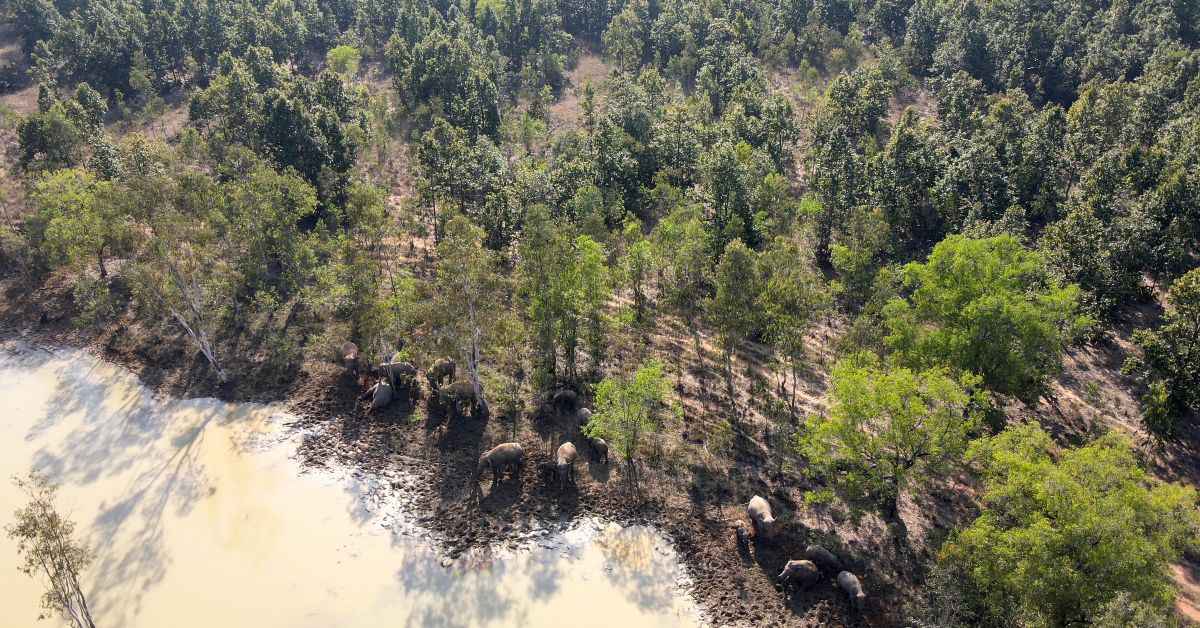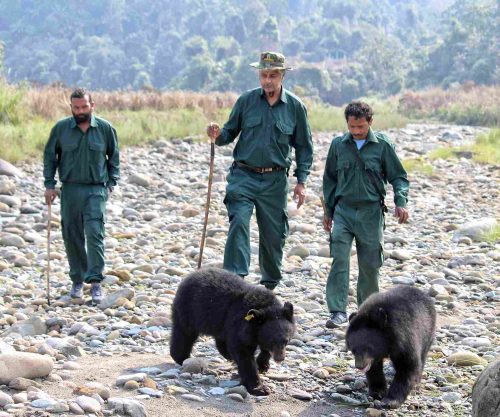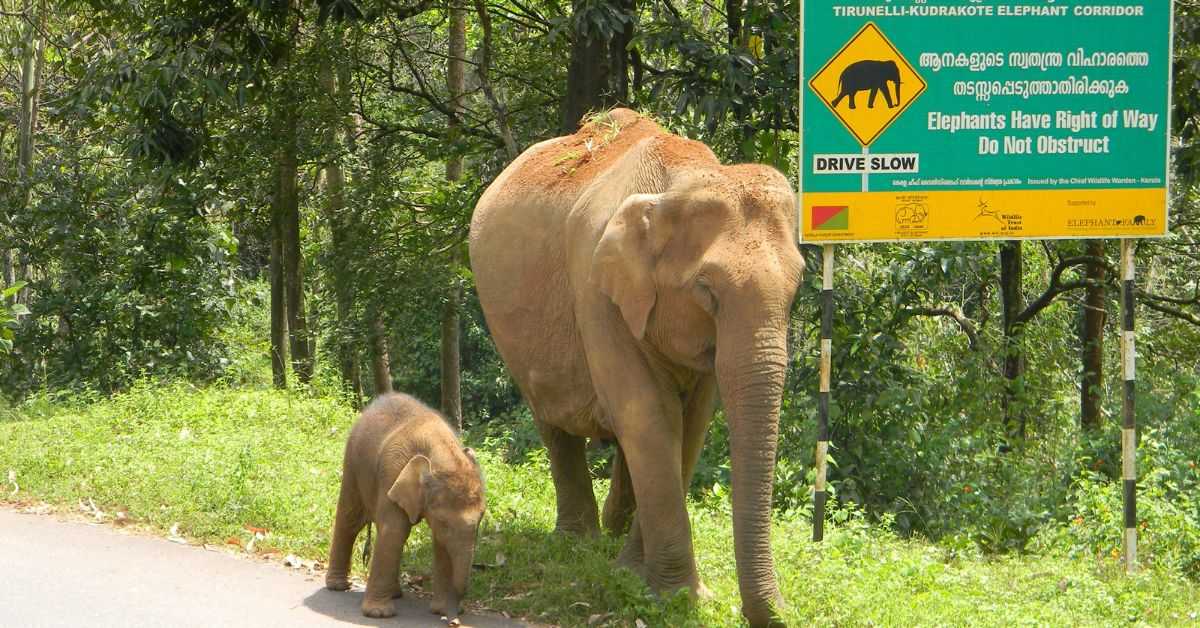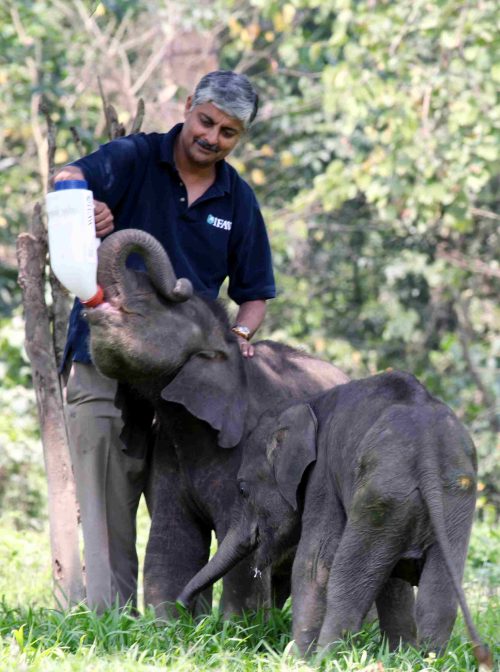A couple of decades ago, in the heart of Uttarakhand’s Jim Corbett National Park, a youth could be seen hiding high up in one of the watch towers. Anyone passing by would wonder about the unusual spot he had picked.
But the answer lay in an amusing scene; every time the young boy attempted to make his way out of the tower, an elephant (camouflaged by the thicket of bushes) would appear and charge at him. And once again, the boy would ascend the watch tower and wait.
It took all of four hours before the elephant decided to make a move and the youth finally descended the watch tower, relief colouring his face.
The boy in this story was a young Vivek Menon, who is now the co-founder of Wildlife Trust of India — an organisation dedicated to the preservation and protection of wild habitats. This tryst with the elephant left an indelible mark on Menon’s mind. “It made me understand the animal’s strength,” he smiles, quick to add, however, that his love for the wild and nature predates this incident.
There is no singular story that served as inspiration to become a conservationist, Menon insists. But coax him a little, and he says genetics did play its role — “I am from Kerala, the land of elephants” — as did childhood treks. “These were treks to the Himalayas during my school days,” Menon explains. “It would be right to say that I took to animals and birds the moment I was exposed to them.”
At home, Menon’s room resembled an animal shelter. Birds and small animals rescued from the wild and predatory hands found a safe space. “I thought I was doing them [the animals] good by bringing them home,” he justifies. Today, at 56, the conservationist’s work is an extension of that same goodwill.
Such was his love for nature that when he digressed from the career plans his father had for him — a career in automobile engineering — and followed his heart all the way to the zoology laboratory, no one was shocked.
How many hours I have spent watching young bulls playfully test their strength, their nascent ivories never inflicting harm, their trunks loosely entwined & ears aflap while muscle and sinew grind against the other. These young mock-battles train them for later adult life! pic.twitter.com/Em9soIlOnY
— Vivek Menon (@vivek4wild) June 18, 2024
‘I wanted to do something concerning animals’
Question: Is there a better way to interview a conservationist than reaching him through a Zoom call while he is in the heart of a South African jungle?
Absolutely not; just what is needed to add essence to the story.
Menon’s excitement was palpable. As senior advisor to the ‘International Fund for Animal Welfare’ for years now, he was in the Southern African country assisting in an operation that involved radio collaring elephants — a process in which a collar with an attached radio transmitter is put on an animal so that its movements in its natural habitat can be remotely monitored.
In fact, as he jokingly adds, my interview call is interrupting something very important that he’d otherwise be doing — watching 150 elephants against the setting sun in Zimbabwe.
Anyone who has watched Menon around elephants would testify that the two share a bond. He understands them. And the relationship is reciprocal.
Substantial proof of his love for the wild lies in the five organisations that he has created — TRAFFIC India — a wildlife trade monitoring network; NGO Srishti — an organisation founded to protect the environment in Delhi; Delhi Bird Club; Venu Menon Animal Allies Foundation; and Wildlife Trust of India (WTI).

Picture a world where trade in wild plants and animals is managed at sustainable levels without damaging the integrity of ecological systems.
This is what TRAFFIC India has attempted to do since the outset. Menon who co-founded this wildlife trade monitoring network with his colleague and legendary conservationist Ashok Kumar, emphasises the organisation’s resolve to bust poaching amid other illegal activities. The organisation’s work also extends to the fight against illegal international ivory trade. Menon’s work earned him the RG Samsara Lifetime Achievement Award in 2017.
While activism is important, this biologist believes in shedding an equal spotlight on creating impact through policy frameworks. As Chair of the Asian Elephant Specialist Group for the IUCN (International Union for Conservation of Nature) for the past 12 years, Menon elaborates on the nature of his work in advising various governments on “doing things right for elephants”.
“This includes bringing out scientific work, guidelines, and manuals. It also includes planning linear infrastructure; highways, railways, road passes, and power lines in such a way that the elephants are allowed to pass,” he notes.
This segues into the topic of identifying and protecting elephant corridors, a brainchild of the Wildlife Trust of India.
With the overarching goal being to secure a ‘rite of passage’ for big mammals, WTI along with the Government of India and top scientists have identified and surveyed 101 such functional corridors across 11 states for the 29,000 odd Asian Elephants in India.
From a spare bedroom project to a phenomenal trust
According to a 2023 study in the Journal of Wildlife and Biodiversity, corridors are short strips of forests that link two larger parts of the forest; like a “continuous two-dimensional landscape structure that interconnects two or more previously linked areas of animal habitats”. These enable the animals to disperse, reduce their risk of separation and make habitat rehabilitation easier.
The study explored how anthropogenic stress, the development of roads and railways, and hydroelectric projects are hampering these corridors. The problem is compounded by multiple forests being turned into croplands by the farming community.

For 25 years, WTI has attempted to better the narrative for wildlife across species. Their impact is resounding — campaigning for the whale shark to be made the first fish to be protected under the Wildlife (Protection) Act, 1972, in India, exposing the illegal mongoose hairbrush trade, assisting in the seizure of over 275 wildlife articles including tiger bones and bear bile, and the inception of the pangolin trafficking project that attempts to curb illegal trade of the species.
The success of the organisation masks its humble beginnings. But Vivek Menon hasn’t forgotten these. “We started as a team of three people in a spare room of my house. Each of us invested Rs 5,000,” he smiles. The investment was secondary. Passion was what drove WTI to success.
Menon has a piece of advice that he believes will go a long way in ensuring a better place for wildlife, including elephants, on the planet.
Firm anti-poaching policies
Having spent the better part of his life as a conservationist training Indian forest guards, rangers, and paramilitary forces on anti-poaching activities and smuggling techniques, Menon has witnessed the network close up. But he insists that, as in the case of any illegal activity, there isn’t a way of curbing it completely. “One can only lessen it,” he says.
To this end, Menon says the forest guards are often the first line of defence to stop illegal trade. “They should be trained in anti-poaching.” He adds that in cases of the animal being poached despite precautionary measures, the border staff should be trained to ensure that smuggling of ivory is not happening.
Reducing man-animal conflict
Crop raiding and property destruction are the prime factors that cause elephant-human conflict, according to the International Fund for Animal Welfare. The study went on to add that in India, 100 elephants die annually from conflict with humans.

The problem, says Menon, is exacerbated by lack of space. “An elephant is a big, intelligent social nomad. It has to move; it has to do so in groups; and it is intelligent. Whatever stands in its way it will destroy to move. One has to respect it and give it space,” he notes.
Create elephant corridors
In a perfect world, the habitats of elephants are contiguous, Menon points out. “Elephants would be able to move from the Himalayas to the South of India.” But he adds that the reason this is no longer possible is because the mammals now share the ground with people and their settlements.
Elaborating on WTI’s approach to demarcate the elephant corridors and push for them to be declared as protected zones, Menon says, they relied on elephant footpaths. “We mapped these and showed it in a publication, explaining why they were integral pieces of land that connected with the different habitats. We delineated these on paper, asking the Government to protect these elephant corridors.”
Sharing the learnings they had during the project, Menon says the protection of elephant corridors can be done in four ways.
The first model, he says, is the community model in the Northeast, which has been on for the past two decades. “This model focuses on land being kept aside by the community for elephants to move. It also involves rewarding the community with some benefits,” Menon shares.
The second model is pushing the Government to acquire land and conduct linear infrastructure mitigations. The third, he says, is to create a community of people who are trained in keeping an eye out for elephant movements. “For instance, in Kaziranga, there are groups of young boys who are on alert. They stop cars to allow the elephants to cross.”
The fourth, he adds, is to relocate villages. This “last-ditch effort” is only resorted to in areas where people have settled right in the middle of elephant corridors and elephants are killing them and not letting crops grow, he shares.

Rescue and rehabilitation
Twenty years ago when Menon and his team started the rescue and rehabilitation of orphan elephant calves to reintroduce them into the wild, people discouraged the idea. But the conservationist points to the 50 percent success rate they have achieved as a nod to their persistence.
Putting policies in place
In 2001, Menon received the Whitley Award for a project focusing on ‘Monitoring of Elephant Poaching and Ivory Trade in India and Asia’. Reaching this zenith of excellence gave tremendous backing to his work in putting wildlife corridors on the map.
In 2020, when India’s Supreme Court earmarked the Sigur Plateau — which sees the movement of around 6,300 Asiatic Elephants — as an elephant corridor, Whitley Fund for Nature notes how the apex court used Menon’s evidence of the benefits to both wildlife and people. Menon’s work has created ripples; shaping the crux of wildlife policies as we speak.
I can sit and listen to him for hours. But I know he has somewhere to be; I’m keeping a hundred and fifty of his jungle friends waiting for him.
“But one last question before you go,” I say, unable to stop myself.
“What do you see in them that connects you to them?”
“They are near persons, if you look at them in terms of conscience, memory, and intellect. They are very similar to us. They might not be able to understand my words or my language. But they understand me in other ways,” he says, before he concludes our conversation to head to the place where he feels most at home — amid the elephants.
Sources
Elephant Corridor loss due to anthropogenic stress – a study of change in forest cover using satellite data in the Sonitpur District, Assam, India by Journal of Wildlife and Biodiversity, Published on 7 June 2022.
Human-elephant conflict: What it is and why it’s a major threat by IFAW, Published on 20 July 2023.
Monitoring of elephant poaching and ivory trade, India and Asia by Whitley Fund for Nature.
Edited by Pranita Bhat.
No comments:
Post a Comment